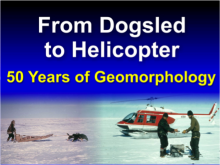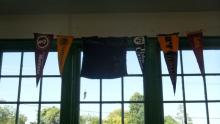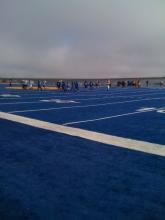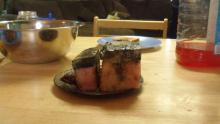What Are They Doing?
Permafrost is any part of the ground (soil, rock, ice, humus) that remains at or below freezing for more than one year. The research team studied the active layer of the permafrost, the layer of the ground between the surface and the permafrost that freezes each winter and thaws each summer. They visited numerous research sites, and at each site, they collected data on the soil and air temperature, soil moisture content, and active layer depth and changes. Observational data from each site included noting changes in landscape and vegetation.
The research sites they visited are part of the Circumpolar Active Layer Monitoring Network (CALM) – a network of 168 sites to observe and measure changes in permafrost. CALM was established in the early 1990’s and strives to collect a long-term record of permafrost data, which can be used to show how changes in arctic climate are affecting frozen ground and assist in climate models.
Warming temperatures in the polar regions could lead to a thicker active layer. This in turn can change the moisture and plant communities on the soil surface, and lead to damaged roads and structures where people live on permafrost. Thawing permafrost also releases greenhouse gasses, such as methane and carbon dioxide, into the atmosphere.
Where Are They?
The team met up in Anchorage, Alaska for training, and then traveled to Fairbanks, Alaska where they traveled via pick-up truck to field sites along the Dalton Highway, a remote 400-mile road that crosses the North Slope of Alaska.
The team spent some time working at Toolik Field Station, located in the foothills of the Brooks Range in northern Alaska. Toolik Field Station is managed by the University of Alaska Fairbanks and has hosted hundreds of researchers and students each summer since 1975.
They also worked out of Deadhorse, a small town on the North Slope of Alaska. The town consists mainly of facilities for the workers and companies that operate at the nearby Prudhoe Bay oil fields.
The team also visited research sites near Barrow, Alaska. Barrow is located on Alaska’s North Slope near the shoreline of the Arctic Ocean. Barrow is a small community of approximately 4,500 people, primarily inhabited by Inupiat Eskimos, and is not accessible by road.
Latest Journals

Dr. Anna Klene is an Associate Professor in the Department of Geography at the University of Montana. She has been going to the North Slope of Alaska since 1996 to study the interactions between permafrost and climate. Dr. Klene and her students have been working in alpine regions as well, particularly in the northern Rockies. She is also coordinating the Geographic Information Sciences and Technologies Certificate program at the University of Montana.

Dr. Nikolay Shiklomanov is an Assistant Professor in the Department of Geography at George Washington University. He is originally from St. Petersburg, Russia. Dr. Shiklomanov is currently directing the Circumpolar Active-Layer Monitoring Project. This program coordinates the data gathered at 168 sites in 14 countries in the Arctic and Antarctic.

Dimitry Streletskiy is a Post Doc in the Department of Geography at GWU. He is originally from Moscow, Russia. Dr. Streletskiy is working for the Circumpolar Active-Layer Monitoring Project.





